Jaguar Panthera onca is the apex predator
Jaguar Panthera onca is the king… “In the heart of the Pantanal, a silent shadow moves — golden rosettes glinting in the sun. Here, the rivers and forests bow to one ruler… the jaguar, undisputed king of this wild domain.”
That’s a fitting title — in the Pantanal, the jaguar truly reigns at the top of the food chain.
It’s the largest big cat in the Americas. Basicaly, it´s a stealthy hunter with the strongest bite of any wild cat, capable of crushing turtle shells and caiman skulls.
Unlike lions, which rule in groups, the jaguar’s “kingship” is solitary: it patrols vast territories, dominates all other predators, and plays a vital role in keeping the ecosystem balanced.
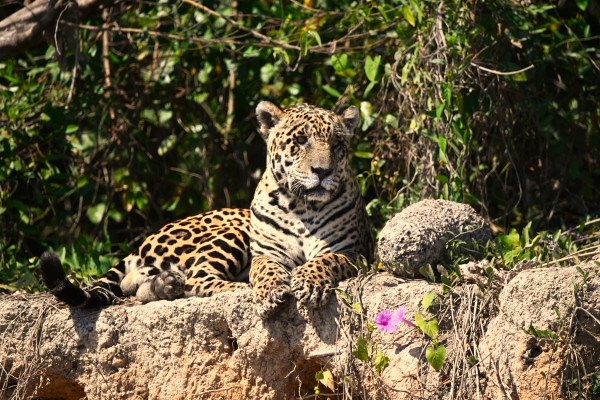
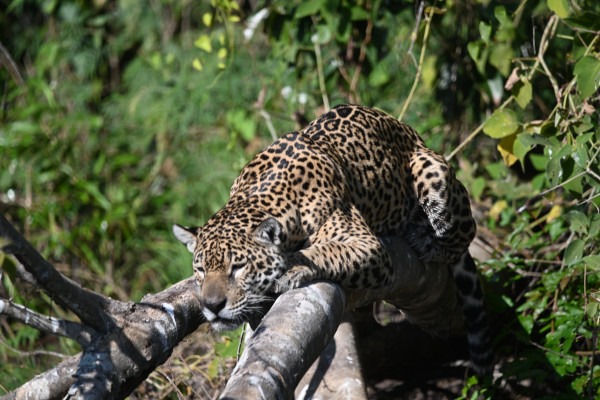
Physical Traits
Jaguar Panthera onca, have a set of physical traits that make them stand out among big cats — and perfectly suited to life in their habitats. Furthermore, here’s a detailed breakdown:
Size and Build
• Body length: 1.1 to 1.85 m (3.6–6 ft), with a tail of 45–75 cm (18–30 in).
• Weight: Usually 45–120 kg (100–265 lb), but exceptionally large males can exceed 150 kg (330 lb).
• Build: Stocky, muscular, and robust — proportionally the most powerfully built of all big cats.
• Head: Broad skull with exceptionally strong jaw muscles.
Coat and Coloration
• Base color: Typically golden-yellow to reddish-brown; some individuals are pale or even melanistic (black jaguars).
• Pattern: Covered with rosettes — irregular black circles with a spot in the middle — which help with camouflage in forests and grasslands.
• Underside: White or pale cream, often extending to the throat and inside legs.
Distinctive Features
• Head-to-body ratio: Larger head in proportion to body size compared to other cats, aiding bite force.
• Bite strength: Strongest bite (relative to size) among big cats; capable of piercing turtle shells and skulls.
• Legs: Shorter but extremely powerful, aiding in pouncing rather than long chases.
• Tail: Shorter than other big cats’ tails — helps maneuver in dense vegetation.
Eyes and Ears
• Eyes: Usually golden or yellow, with excellent night vision for low-light hunting.
• Ears: Small and rounded, helping reduce snagging in thick vegetation and aiding in directional hearing.
Sexual Dimorphism
• Males are generally 10–20% larger and more muscular than females.
If you’d like, I can also make you a side-by-side comparison chart of jaguars versus leopards so you can see the differences in their physical traits clearly. That’s where people often mix them up.
Jaguar Panthera onca behavioral insights
1. Hunting and Feeding
• Ambush predators: Jaguars rely on stealth and short bursts of power rather than long chases.
• Bite technique: Uniquely, they often kill prey with a crushing bite directly to the skull, piercing the brain — unlike most big cats that go for the neck or throat.
• Diet: Opportunistic; will take over 85 different species, from capybaras and deer to caimans, turtles, and fish.
• Water skills: Strong swimmers; hunt along rivers and sometimes leap into the water to catch prey
2. Territoriality
• Solitary lifestyle: Adults generally live and hunt alone, except for mating or females with cubs.
• Territory size: Can range from 25 km² in prey-rich areas to over 150 km² in sparse regions.
• Marking: Use scent marking, urine spraying, and vocalizations (deep “roars” or sawing calls) to advertise territory.
3. Activity Patterns
• Mostly crepuscular and nocturnal: Peak activity at dawn and dusk, but flexible — can be active by day in undisturbed areas.
• Seasonal shifts: In wet season, more active near rivers and flooded areas; in dry season, move further inland if prey concentrates elsewhere.
4. Social Interactions
• Low tolerance for strangers: Encounters between adults can lead to aggression, except during courtship.
• Mating behavior: Brief associations during the mating period; females raise cubs alone.
• Parental care: Cubs stay with the mother up to 18–24 months, learning hunting skills.
5. Communication
• Vocalizations: Deep guttural calls, grunts, and chuffing sounds. Their roar is shorter and raspier than a lion’s.
• Non-vocal signals: Scratching trees, rubbing scent glands, and body posture convey dominance or submission.
6. Adaptability
• Habitat use: Thrive in tropical rainforests, wetlands, savannas, and even scrublands.
• Hunting strategy flexibility: Can stalk silently in dense forest, wait in ambush near game trails, or hunt in water.
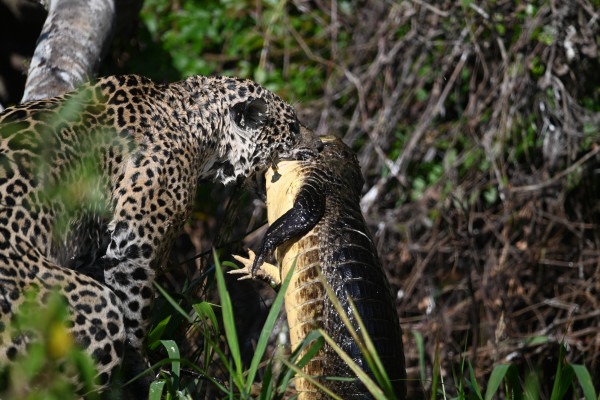
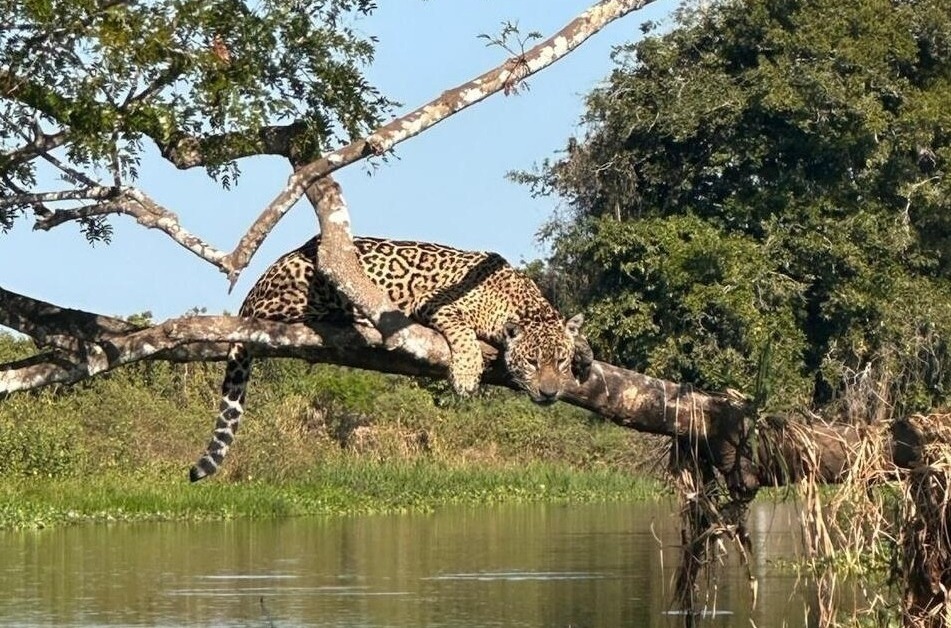
Jaguar Panthera onca habitat overview
Geographic Range
• Historically: From the southwestern United States through Central America and into most of South America.
• Today: Mostly in the Amazon Basin, Pantanal wetlands, and scattered forested areas; largely gone from the U.S. and much of northern Argentina.
• Strongholds: Brazil (Amazon & Pantanal), Peru, Colombia, Venezuela, Bolivia, and parts of Central America.
Preferred Habitats
• Tropical Rainforests: Dense canopy cover provides stealth for ambush hunting; rich in prey diversity.
• Wetlands & Floodplains: Pantanal is prime jaguar country, offering abundant aquatic and terrestrial prey.
• Riverbanks & Lakeshores: Jaguars often patrol water edges for capybaras, caimans, and fish.
• Dry Forests & Savannas: Can survive in more open areas if water and prey are available.
Key Habitat Features
• Water Proximity: Almost always within reach of rivers, lakes, or swamps — jaguars are semi-aquatic hunters.
• Dense Cover: Thick vegetation or forest edge zones for concealment during stalking.
• Prey Richness: Areas with high biomass of medium to large mammals, reptiles, and fish.
Elevation Range
• Typically from sea level to about 1,200 m (3,900 ft). In the Andes foothills, can be found up to ~3,000 m (9,800 ft) in rare cases.
Threats to Habitat
• Deforestation: Agriculture (especially cattle ranching and soybean farming) and logging.
• Fragmentation: Roads and settlements break up continuous habitat, isolating populations.
• Human Conflict: Encroachment often leads to retaliation killings when jaguars take livestock.
Jaguar Panthera onca Conservation Status
Official Status
• IUCN Red List: Near Threatened (globally) — but some regional populations are Endangered or Critically Endangered.
• CITES: Listed in Appendix I — meaning international commercial trade is banned.
• National Protections: Many countries in its range have laws protecting jaguars, but enforcement varies greatly.
Population Trends
• Global population is decreasing.
• Estimated mature individuals: Likely fewer than 64,000 in the wild.
• Distribution is now highly fragmented, with strongholds mainly in the Amazon and Pantanal.
Major Threats
1. Habitat Loss & Fragmentation: Caused by deforestation for agriculture, logging, mining, and infrastructure.
2. Human-Wildlife Conflict: Retaliation killings when jaguars prey on livestock.
3. Poaching: For pelts, teeth, and other body parts — sometimes trafficked to Asian markets.
4. Declining Prey: Overhunting of their main prey species by humans reduces food availability.
Conservation Efforts
• Protected Areas: Key habitats safeguarded in parks like Brazil’s Pantanal Matogrossense and Belize’s Cockscomb Basin Wildlife Sanctuary.
• Wildlife Corridors: Initiatives like the Jaguar Corridor aim to connect isolated populations across the Americas.
• Community Programs: Education and eco-tourism projects encourage coexistence and provide alternatives to hunting.
• Research & Monitoring: Camera traps, GPS collars, and genetic studies help track populations and movements.
Outlook
• The jaguar’s survival depends on preserving large, connected habitats and reducing conflict with humans.
• Conservation is more effective in regions where jaguars are valued as eco-tourism attractions, like the Pantanal, than in areas where they are seen mainly as threats to livestock.
Cultural Significance
Jaguars hold a deep and varied cultural significance across the Americas, stretching from ancient civilizations to modern symbolism. Here’s a full overview:
⸻
1. Ancient Civilizations
• Maya: Jaguars were seen as powerful guardians of the underworld, night, and darkness. They symbolized strength, leadership, and the ability to move between worlds. Elite warriors and rulers often adopted jaguar imagery.
• Aztec: The ocelotl (jaguar) represented bravery and ferocity in battle. The elite “Jaguar Warriors” were among the most feared Aztec military orders.
• Olmec: Among the earliest Mesoamerican cultures to depict jaguars — often in human-jaguar hybrid figures thought to represent shamans or deities.
• Inca: The jaguar (otorongo) symbolized power and was associated with divine authority.
2. Spiritual and Mythological Roles
• Seen as a bridge between physical and spiritual realms due to its nocturnal and elusive nature.
• In Amazonian shamanism, jaguars are often spirit animals or protectors, guiding shamans in visions.
• Symbol of transformation, courage, and connection with nature’s primal forces.
3. Modern Symbolism
• National & Regional Icons: Jaguars appear in the emblems of several Latin American states and conservation organizations.
• Eco-Tourism Ambassadors: Especially in the Pantanal, jaguars have become a draw for wildlife tourism, boosting conservation funding.
• Sports & Branding: Used in team names, logos, and products to represent power, agility, and stealth.
4. Artistic Representation
• Featured in pottery, carvings, textiles, and murals for thousands of years.
• Contemporary artists still use jaguars to represent environmental awareness, indigenous heritage, and cultural pride.
5. Cultural Challenges Today
• While revered symbolically, jaguars often face conflict in rural areas where they threaten livestock.
• Conservation efforts increasingly tie cultural pride to jaguar protection, reviving ancient reverence to promote modern coexistence.
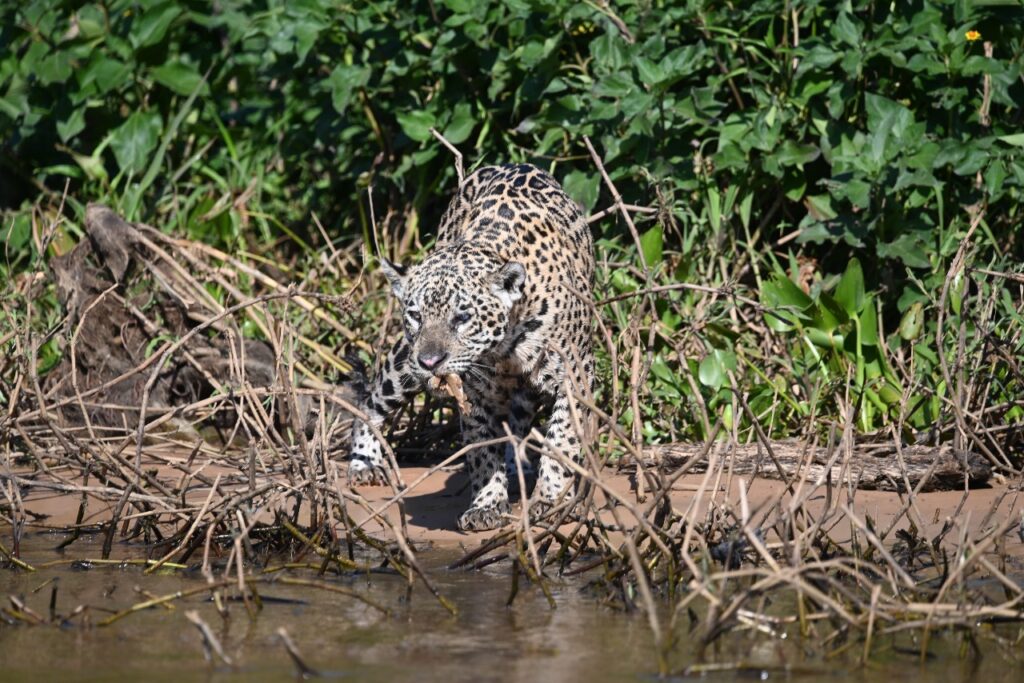
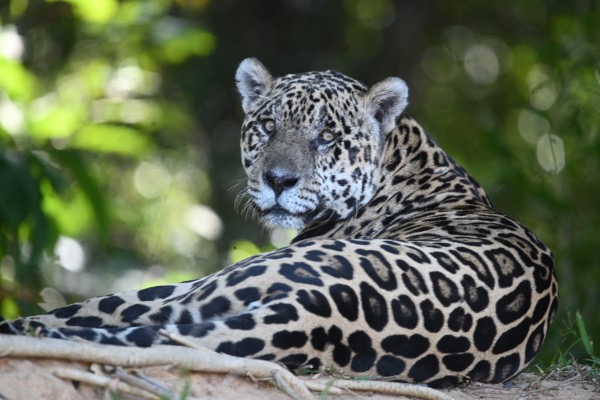
Interesting facts
1. Bite Like No Other
• Jaguars have the strongest bite force relative to size of any big cat — about 1,500–2,000 psi — strong enough to pierce turtle shells and even caiman skulls.
2. Rosette Secret
• Their black spots (rosettes) are unique to each jaguar, working like a fingerprint for identification.
3. Love for Water
• Unlike most big cats, jaguars are excellent swimmers and often hunt in water, catching fish, turtles, and even small caimans.
4. Silent Stalkers
• Jaguars can move almost noiselessly through dense forest thanks to their padded paws and careful stepping.
5. Masters of Ambush
• They can leap more than 5 meters (16 ft) forward in a single pounce to surprise prey.
6. Ancient Royalty
• Revered as gods by the Maya, Aztec, and Inca civilizations, often associated with power, warfare, and the spirit world.
7. Color Variations
• Melanistic (black) jaguars — often called “black panthers” — are not a separate species; their dark coat still has rosettes, visible in bright light.
8. Solitary Travelers
• A single jaguar’s territory can be as large as 150 km² (58 mi²), and males fiercely defend theirs from rivals.
9. Stealthy Communicators
• Their main territorial call is a series of deep, guttural coughs or “sawing” sounds, rather than a lion-like roar.
10. Record Holder
• The Pantanal in Brazil is the best place in the world to see wild jaguars — sightings there are more reliable than anywhere else on Earth.
If you like, I can also put together a “Jaguars: Top 20 Fun Facts” illustrated sheet with quick visuals for each fact — it makes them even more memorable.
